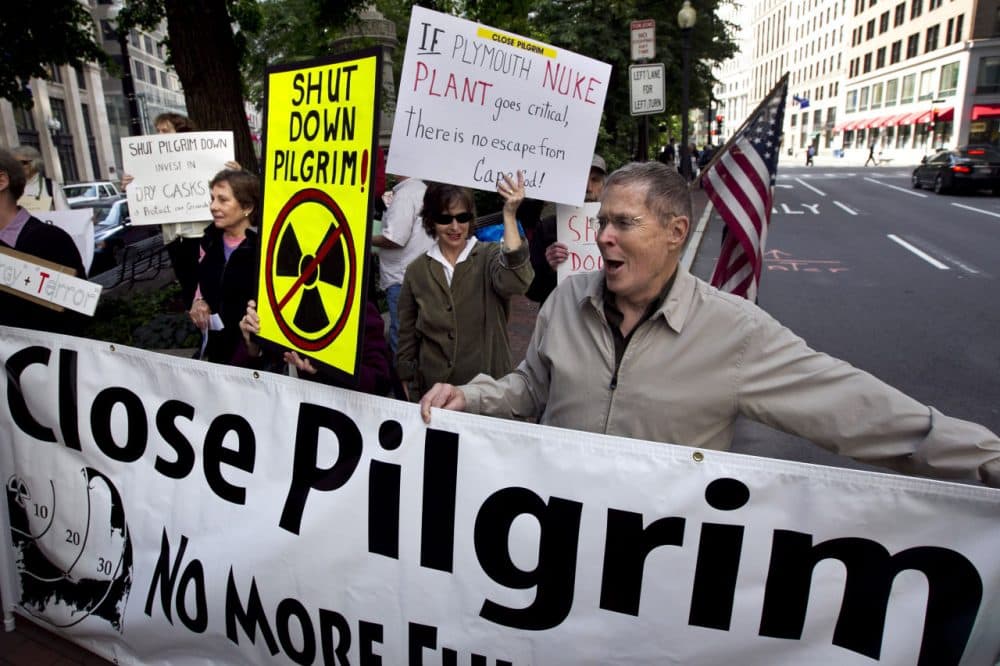Dancing Clown Rick Perry is in charge of Nuclear Arms and Nuclear Power Plants....his 2 predecessors were Nuclear Physicists, one a Nobel Prize Winner.
Below are just a sampling of recent articles including several about the threats posed by AGING and CRUMBLING Nuclear Power Plants that will require taxpayer bailouts:
***Nuclear Energy is DEAD!
RSN: Harvey Wasserman | Donald Trump & Andrew Cuomo Are Brothers in Reactor Disaster
EXCERPT:
"....As Trump sabotages the dollar, watch him blame our economic death spiral on Muslims, commies, immigrants, and people of color.
Trump’s wedge between the US and Germany is a dream come true for Putin’s petro-mafia.
So is his attack on climate science as he hands our techno-future to King CONG (Coal, Oil, Nukes and Gas), the obsolete monster of a failed 20th century past.
Trump’s hatred of Solartopian technologies — solar, wind, tidal, wave, ocean thermal, geothermal, LED, efficiency, electric and hydrogen cars, advanced batteries, etc. — leaves the US out of the biggest job-creating transition in human history....."
"...No commercial reactor has liability insurance, so the next melt-down/explosion could bankrupt us all, with none of Trump/Cuomo’s industry cronies held responsible....."RSN: New York's Cuomo Tries to Bail Out Dying Nukes
"...But now Cuomo wants to earmark more than $7 billion in public money, for starters, to keep four upstate nuclear reactors on line. One is the Ginna reactor, near Rochester; the other three—FitzPatrick, Nine Mile Point One, and Nine Mile Point Two—occupy a single site on Lake Ontario. Fitzpatrick is owned by Entergy. The rest are owned by Exelon, the nation’s largest nuclear power owner/operator.
All four reactors are in various stages of advanced deterioration and were slated for permanent closure. Without massive public subsidies, none can compete with natural gas or with wind and solar, which are rapidly dropping in price.
Entergy announced last fall that economic factors would force it to shut Fitzpatrick in January 2017. Exelon told the New York Public Service Commission that it would probably shut Nine Mile 1 and Ginna next year as well. .."
Nuclear? Tired of PROPAGANDA?
Electric Trains Everywhere: A Solution to Crumbling Roads and Climate Crisis
http://readersupportednews.org/news-section2/318-66/43933-electric-trains-everywhere-a-solution-to-crumbling-roads-and-climate-crisis
Harvey Wasserman | Three Mile Island Nuke Plant Closure Strengthens Call for Renewable Energy Future
http://readersupportednews.org/opinion2/277-75/43888-focus-three-mile-island-nuke-plant-closure-strengthens-call-for-renewable-energy-future
With Age, Comes GREED from Casino Vulture Sheldon Adelson
Report: Years of issues at Pilgrim nuclear plant
By Christine Legere
Posted Jun 19, 2017
PLYMOUTH — Pilgrim Nuclear Power Station leads the nation’s fleet of 99 reactors for incidents or conditions over the last 40 years that could have led to core damage and an accompanying release of radiation, according to a division of the Nuclear Regulatory Commission that conducts risk analysis.
While not among the 11 reactors on the 2016 list published June 8 by the NRC’s Division of Risk Analysis, Pilgrim has made the list for “accident sequence precursors” 23 times since 1980.
Such precursors are defined by the NRC as observed events or conditions that, when combined with one or more factors such as human error or equipment failure, could result in damage to the reactor’s core and a massive release of radiation.
“The accident sequence precursors are like golf scores, in that the low score wins,” said David Lochbaum, director of the Nuclear Safety Program for the Union of Concerned Scientists.
While the 45-year-old Plymouth plant, owned by Entergy Corp., was on the annual list only four times in the past 20 years, all four of the potentially dangerous incidents have been recent, occurring since 2011.
In May 2011, operators made a series of faulty judgments on power levels as they powered the reactor back up. Those failures to properly assess reactor activity ultimately triggered an automatic shutdown. The situation was judged by federal regulators as an accident sequence precursor.
The other three events — two in 2013 and one in January 2015 — involved unplanned shutdowns following electrical problems in the plant’s switchyard during storms. Contributing to those incidents were operator error and equipment failures. Short circuits in the switchyard at Pilgrim have been a recurring problem, noted the researchers in their report, involved in 13 of the 23 accident sequence precursor total.
NRC spokesman Neil Sheehan said those three recent weather-related events at Pilgrim and the plant workers’ response to those events “are a significant contributor to Pilgrim’s placement in Column 4.”
Since the fall of 2015, Pilgrim has been ranked by federal regulators in a performance category just one step above ordered shutdown, based on standards set by the Nuclear Regulatory Commission. Because of its ranking as one of the three worst performers in the country, Pilgrim was required to undergo 12,000 hours of federal inspection last year.
Lochbaum called the nature of the Pilgrim events on the accident sequence precursor list over the years “not surprising.”
“The list includes safety relief valve problems, losses of offsite power, and high pressure coolant system failures — the same problems that factored in recent Nuclear Regulatory Commission findings and sanctions,” he said.
Risk analysts began their 2016 study by scrutinizing the 350 event reports turned in to the NRC by reactor licensees during the year; they whittled that list to 63 that needed further analysis. Two of those were incidents at Pilgrim, which were eventually screened out.
A third incident at Pilgrim was not considered for the list because it is still being evaluated.
The first incident dates back to April 12, 2016, when workers took one of two emergency generators offline for maintenance, believing the second was in good working order. More than 25 hours after shutting down the first generator, a worker noticed water leaking across the floor from the second. The leak was caused by stress corrosion and the generator was declared inoperable.
The second incident, which also occurred in April 2016, involved relay tests that were done while the reactor was powered up instead of in cool shutdown, as technical standards called for.
A third incident, which will be analyzed by inspectors after more information is provided by Entergy, involved a leaking relief valve that put one of the emergency generators out of service due to low gearbox oil.
Spokesman Patrick O’Brien said Entergy has been hard at work addressing plant deficiencies. “The events documented in this analysis have been thoroughly evaluated by Entergy and by the Nuclear Regulatory Commission through its various oversight processes,” wrote O’Brien in an email to the Times. “Corrective actions to address the causes are consistent with the station’s ongoing efforts to strengthen our performance.”
“Entergy also made a significant investment in equipment reliability improvements” during the plant’s recent refueling and maintenance outage, O’Brien said.
A look at the accident sequence precursor events over the past 10 years “reveals no statistically significant increase or decrease in trends,” the report notes. A review of the past 20 years, however, reveals two statistically significant trends: more occurrences in boiling water reactors (like Pilgrim’s), and more precursors that are related to emergency diesel generator failures.
— Follow Christine Legere on Twitter: @ChrisLegereCCT.


No comments:
Post a Comment